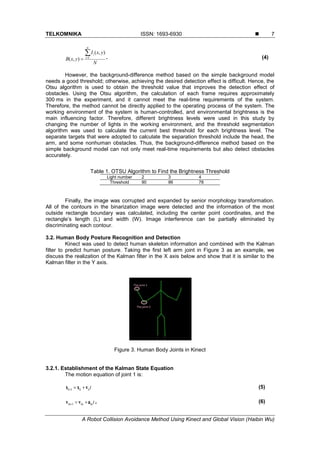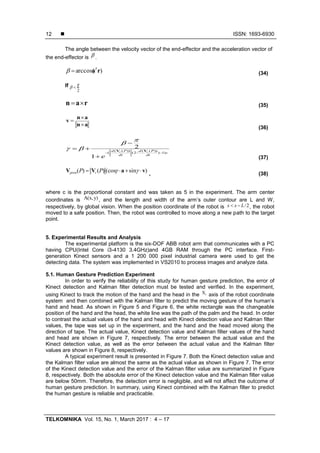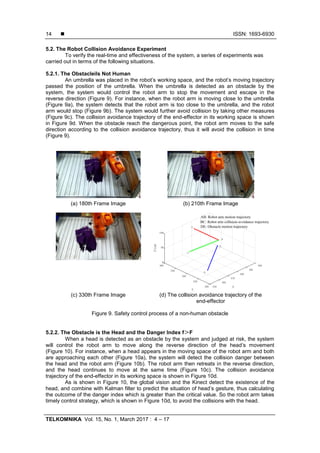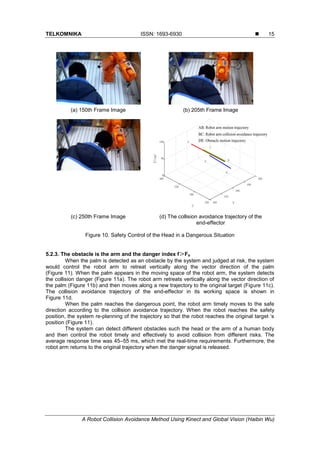This document describes a robot collision avoidance method using Kinect and global vision. Global vision is installed above the robot to detect potential collision objects in real-time using background subtraction and thresholding algorithms. Kinect detects human skeletons and uses a Kalman filter to predict joint positions over time. The predicted joint positions are used to calculate a human joint danger index to evaluate collision risk levels. Different motion control strategies are then applied depending on the obstacle category and danger index value.
![TELKOMNIKA, Vol.15, No.1, March 2017, pp. 4~17
ISSN: 1693-6930, accredited A by DIKTI, Decree No: 58/DIKTI/Kep/2013
DOI: 10.12928/TELKOMNIKA.v15i1.3566 4
Received August 5, 2016; Revised November 28, 2016; Accepted December 16, 2016
A Robot Collision Avoidance Method Using Kinect and
Global Vision
Haibin Wu*, Jianfeng Huang, Xiaoning Yang, Jinhua Ye, Sumei He
School of Mechanical Engineering and Automation, Fuzhou University, No.2, Xueyuan Road,
Shangjie Town, Fuzhou City, Fujian Prov, 350116, China
*Corresponding author, e-mail: wuhb@fzu.edu.cn
Abstract
This paper introduces a robot collision avoidance method using Kinect and global vision to
improve the industrial robot’s security. Global vision is installed above the robot, and a combination of the
background-difference method and the Otsu algorithm are used. Human skeleton detection is then
introduced to detect the location information of the human body. The collided objects are classified into
nonhuman and human obstacle which is further categorized into the human head and non-head areas
such as the arm. The Kalman filter is used to predict the human gesture. The human joints danger index is
used to evaluate the risk level of the human on the basis of human body joints and robot’s motion
information. Finally, a motion control strategy is adopted in view of obstacle categories and the human joint
danger index. Results show that the proposed method can effectively improve robot’s security in real time.
Keywords: robot safety, human body skeleton detection, Kalman filter, global vision, security control
Copyright © 2017 Universitas Ahmad Dahlan. All rights reserved.
1. Introduction
Safety control strategy must be taken to avoid the collision between the moving robot
and the operators in the working space [1]. Strategies used in safe human-robot collaboration
(HRC) can be broadly divided into two categories: pre-collision strategy [2-4] and post-collision
strategy [5]. The former strategy detects the danger before the collision and takes measures to
prevent imminent collision. While the latter one requires higher real-time performance during the
collision to suppress the impact force, and ensure the security of operators and robots.
Therefore, pre-collision methods can normally achieve safer result in implementation of HRC.
Researchers have been working on different pre-collision methods and presenting some
important findings and solutions. As one of the pre-collision methods, sensors, such as
ultrasonic [6] and photoelectric sensors, are installed on the robot to detect the man–machine
position. The sensors identify the danger and then the robots will be immediately stopped. Such
security strategy is very simple, and greatly reduce the reliability of collision avoidance and the
work efficiency of the robot.
The robot should follow the collision avoidance strategy at all run time. A more reliable
safety strategy is essential. Sanderud [7] have presented proactive safety strategy based on a
quantified measure of risk for human robot collaboration. The risk field is established based on
an analysis of the human’s movement and the consequence of a collision with different human
limbs, combined with a likelihood analysis. Similarly, a simulation tool using real-world
geometrical data was proposed to investigate different algorithms and safety strategies [8].
Kulić [9, 10] suggested a method of robot safe trajectory planning based on the mechanical
principle of the minimizing danger index. However, the application of this method is limited by
the large number of environmental data required.
One of the most common and useful technologies used to detect intruding obstacles is
robot vision. The robot vision has been developed in recent years, and could be a feasible
solution in the collision avoidance strategy. A robot manipulator automatic path planning
strategy based on 3D-TOF sensor was presented in peg-in-hole assembly process [11].
Similarly, a two fold strategy was presented to automatically generate safe path for robot
trajectory based on data from TOF sensor [12]. Kuhn [13] used monocular vision to measure the
human–robot distance in manipulator space and thus identified the risk. Yet this method is not
conducive to the human–robot collaboration because of its limited detection of monocular vision,](https://image.slidesharecdn.com/023566-200902070344/85/A-Robot-Collision-Avoidance-Method-Using-Kinect-and-Global-Vision-1-320.jpg)
![TELKOMNIKA ISSN: 1693-6930
A Robot Collision Avoidance Method Using Kinect and Global Vision (Haibin Wu)
5
and single control strategy. Diffrent actions should be taken for diffrent obstacles in robot work
space such as humans, animals and objects. Only depanding robot vision is hard to distingguish
all kinds of obstacles, especially for humans and non-humans.
Kinect is an advanced motion tracking sensor, and it can be used for identifying
individuals in the robot work space. In [14], an obstacle detection method using Kinect was
designed to obtain the obstacle’s information. By designing an artificial parallel system of the
manipulator in the obstacle avoidance controller, the proposed control method enables the
robot to achieve the ability of moving away from the obstacle. He has also investigated [15] and
used Kinect to obtain the obstacle information. This scheme is mainly used for mobile robot to
avoid obstacles and is not used in man-machine cooperation environment. Flacco [16]
calculated the human–robot distance to determine the danger level and took the safety control
measures in the Kinect depth space. This method cannot accurately distinguish human body
parts, quantitatively evaluate the movement state, or take effective control measures in time.
This study proposes an improved method to detect and control the robot. Global vision
is used to identify the danger of collision. Kinect, combined with the Kalman filter, is used to
discriminate the obstacle and detect the human gesture. The specific motion control strategy is
adopted depending on different situations.
2. Robot Collision Avoidance System Scheme
As shown in Figure 1, the project consists of a six-degrees-of-freedom (DOF) robot arm,
Kinect, an industrial camera, and a personal computer (PC). Kinect and the camera transmit
data to the PC by the universal serial bus (USB) port; simultaneously, the PC and the six-DOF
robot arm transmit parameters and control movement from each other via the transmission
control protocol/internet protocol (TCP/IP). As shown in Figure 1, the industrial camera and
Kinect are installed above and in the rear of the six-DOF robot arm, respectively. The detection
area can cover the entire working area of the robot arm by adjusting the locations of the
industrial camera and Kinect (Figure 2).
Figure 1. System Architecture Model
Figure 2. Assembly Position](https://image.slidesharecdn.com/023566-200902070344/85/A-Robot-Collision-Avoidance-Method-Using-Kinect-and-Global-Vision-2-320.jpg)
![ ISSN: 1693-6930
TELKOMNIKA Vol. 15, No. 1, March 2017 : 4 – 17
6
In this system, the colliding signal of obstacles should be identified first. Hence, global
vision and the background-difference method are adopted to detect human and nonhuman
obstacles. Upon sensing a potential collision, global vision transmits the danger signal to the
robot arm controller for the arm to take safety control measures in time. Kinect then identifies
whether or not the obstacle is a part of the human body [17, 18]. If the obstacle is a part of the
human body, Kinect combined with the Kalman filter detects and predicts the pose of the human
body to calculate the current human joint danger index. This index can be used to classify the
danger level compared with the danger index threshold, which transmits different danger signals
to make the robot arm take different control strategies.
The Kalman filter can predict the next position and velocity of the object on the basis of
the current position of the object [19, 20]. Noise often interferes with the measurement of the
position and the velocity of the object; thus, the Kalman filter uses the dynamic information of
the object to eliminate the influence of noise and estimate the position of the object accurately.
3. Obstacle Hazard Detection
3.1. Global Vision
3.1.1. Coordinate System Transformation
The Pinhole imaging principle was adopted in this study to understand the
transfromation between the image coordinate system and world coordinate system. As shown in
Figure 1, ,(X ,Y Z )c c c
and (X ,Y ,Z )w w w are the coordinates of the camera coordinate system and the
world coordinate system, respectively. (u,v) is the image pixel as the unit of the image
coordinate. Therefore, the expression is [21]
0
w
x
ud d
X
. (1)
0
w
y
d d
Y
, (2)
where d is the image distance and ),( 00 is the center point coordinate of the image plane. The
internal parameters of the camera ( x and y
) must be obtained via camera calibration to
converted the image coordinate system into the world coordinate system. The chessboard
method was adopted for calibration. The expression of the relationship between the camera
coordinate system and the world coordinate system is:
0 1 0 428
1 0 0 105
0 0 1 1800
1 0 0 0 1 1
c w
c w
c w
X X
Y Y
Z Z
. (3)
Thus, the transformation between the robot arm coordinates system and the image coordinate
system can then be realized .
3.1.2. Detect Potential Collision Objects
The entire control system must be in real time. Thus, the image processing data should
be minimized and meet the requirements of target detection. Image Pyramid was used to
reduce the sampling and the image resolution by Gauss transform.
The background-difference method was adopted to detect obstacles. Its background
modeling method includes (1) the simple background model, (2) the single Gauss background
model, and (3) the mixed Gauss background model. The efficiency of the background-difference
method, based on the simple background model, is the highest on the basis of experiment
comparison, which can meet the real-time requirement of the system. In this system, the
background model was built via image sequence synthesis. The frame i of the sampled image is
defined as ( , )iI x y , the background image is expressed as ,B x y( ), and the total number of frames
is N:](https://image.slidesharecdn.com/023566-200902070344/85/A-Robot-Collision-Avoidance-Method-Using-Kinect-and-Global-Vision-3-320.jpg)

![ ISSN: 1693-6930
TELKOMNIKA Vol. 15, No. 1, March 2017 : 4 – 17
8
where kx , kxv , and kxa are the coordinates, velocity, and acceleration of joint 1 in the X axis in
K time, respectively, and t is the time interval between the two frame images. tkxa can be used
as white noise in the practical calculation.
The position and velocity of the joint point can be expressed by the state equation of the
joint point, velocity information also contains motion direction information. Therefore, the state
equation can be established by the motion equation of the joint 1. The system state equation is
computed as
t
t
kxkx
k
kx
k
av
x
v
x 0
10
1
1
1
.
(7)
3.2.2. Establishment of the Kalman System Observation Equation [22]
The Kalman system observation vector not only corrects the prediction data of the last
round of Kalman iterative algorithm, but also prepares for the next round of iterative algorithm.
Because the observed joint position is the actual position of the joint pointion in the Kinect
coordinate system, the joint position is calculated as:
kx
k
kx
k
v
x
v
x
01
1
1
,
(8)
and the observation coefficient matrix is:
10
01
)(kF
.
(9)
3.2.3. Initialization Filter
First round iteration of Kalman filter needs to intitialize various vectors. When the
human body first appeared, according to the observational position of human joints, the filter
state is initialized to:
T
x 0,00 0
S
.
(10)
The system initial state vector covariance matrix could obtain a large value from the
diagonal of the matrix. The values are obtained according to the actual measurement situation
and are not influenced after filtering for some time. For the first time, the value is:
222
22
/10/10
/1010
)00(
tt
t
P
. (11)
The system dynamic noise covariance matrix is:
100
010
0Q
.
(12)
3.2.4. Kalman Filtering Algorithm Iterative Process
On the basis of the state vector prediction equation, the state of joint 1 in frame k+1 of
image is predicted to be:
)()()1( kkkkk
SHS . (13)
The prediction equation of the state vector covariance matrix is:
)()()()()1( kkkkkkk T
QHPHP . (14)](https://image.slidesharecdn.com/023566-200902070344/85/A-Robot-Collision-Avoidance-Method-Using-Kinect-and-Global-Vision-5-320.jpg)

![ ISSN: 1693-6930
TELKOMNIKA Vol. 15, No. 1, March 2017 : 4 – 17
10
'
tan
'
m m
m m
Y Y
X X
(19)
(20)
cos mm vv (21)
sincos kykxk vvv
(22)
safetyyxcondition
dangeryxcondition
Xx
Xx
DI mk
mk
mk
),(0
),(( ''
)vv
, (23)
where kv and mv are the velocity vectors, which include the moving direction information of the
industrial robot and the human body joint. Therefore, the danger index also contains the
direction information of the relative movement of the robot arm and joint 1, and the danger index
plays a vital role in detecting the danger signal.
If joint 2 is closer to the robot arm than other parts, then it is used as a reference point.
When the obstacle is a human head, the calculation is the same as above. The method is based
on the danger index and combined with global vision’s obstacle information detection to sense
the collision danger in real time.
4. Specific Motion Control Strategy
When detecting the collision danger, control measures must be taken effectively to
ensure safety. In this study, the situation where the obstacle is a human body or a different part
of a human body determines which effective control strategy should be taken, as well as which
strategy can make the system successfully protect the robot arm and the people [23].
The collision danger signal is composed of the signals provided by Kinect and global
vision, which determine the type of obstacle and the danger degree of collision. Therefore, the
selection of the control strategy is mainly based on the following three aspects:
(1) The control strategy can protect the robot as much as possible, so that the robot will
deal with an impending dangerous situation better.
(2) When the obstacle is a part of the human body, the control strategy should give the
human body the priority protection.
(3) The control strategy, in the role of protection, should not affect the efficiency of the
robot after the danger signal released.
4.1. If the Obstacle is not human
The robot arm was controlled to move vertically along the direction of the end-effector
and the obstacle center. While image processing, the center point coordinates of the obstacle
detection is A(x,y), the end-effector coordinates of the robot arm is 1 1B(x ,y ), the end-effector
velocity of the robot arm is )(PrV , and the motion velocity of the robot arm after control
measures is
)(PpivotV
. The robot arm collision avoidance trajectory was calculated by the
following algorithm.
When the danger signal is detected, the vector a between the end-effector of the robot
arm and the obstacle center is:
BA
BA
a .
(24)
At this point, the motion vector direction of the end-effector is:](https://image.slidesharecdn.com/023566-200902070344/85/A-Robot-Collision-Avoidance-Method-Using-Kinect-and-Global-Vision-7-320.jpg)





![ ISSN: 1693-6930
TELKOMNIKA Vol. 15, No. 1, March 2017 : 4 – 17
16
(a) 200th Frame Image (b) 260th Frame Image
(c) 300th Frame Image (d) The collision avoidance trajectory of the
end-effector
Figure 11. Palm’s Safety Control in a Dangerous Situation
6. Conclusion
This paper presents a pre-collision method based on global vision and Kinect for robot
movement’s security. The system is simple in structure because it can recognize the human
body and nonhuman obstacles accurately and calculate the danger index by using the Kinect
and Kalman filter algorithm when the obstacle is a human body. Moreover, the danger index is
used as a basis by the system when assuming a different security control strategy, thereby
ensuring the safety of the human body and the robot arm.
This pre-collision method can be applied to man-machine cooperation of industrial
robots. A series of experiments on the six-DOF ABB robot arm using this system confirmed the
real-time effectiveness and satisfactory performance of the method. Thus, the method can
improve the safety of the robot’s movement effectively when the effect on the working efficiency
of the robot is minimal.
Acknowledgements
This study is supported by the National Natural Science Foundation of China (No. 5117
5084 and 51575111), and University-Enterprise Cooperation Project (2015H6012).
References
[1] Haibin Wu, Jianming Yang. Progress in robot safety research during human-robot interaction. China
Safety Science Journal. 2011; 21(11): 79-86. (Chinese)
[2] Flacco F, De Luca A. Multiple Depth/Presence Sensors: Integration and Optimal Placement for
Human/Robot Coexistence. Robotics and Automation (ICRA), 2010 IEEE International Conference on.
2010; 3916–3923.
[3] Najmaei N, Kermani MR. Prediction-Based Reactive Control Strategy for Human-Robot Interactions.
Robotics and Automation (ICRA), 2010 IEEE International Conference on. 2010; 3434–3439.](https://image.slidesharecdn.com/023566-200902070344/85/A-Robot-Collision-Avoidance-Method-Using-Kinect-and-Global-Vision-13-320.jpg)
![TELKOMNIKA ISSN: 1693-6930
A Robot Collision Avoidance Method Using Kinect and Global Vision (Haibin Wu)
17
[4] Carlos Morato, Krishnanand N Kaipa, Boxuan Zhao et al. Toward Safe Human Robot Collaboration by
Using Multiple Kinects Based Real-time Human Tracking. Journal of Computing and Information
Science in Engineering. 2014; 14(1): 011006.
[5] Dongjun Shin, Irene Sardellitti, Yong-Lae Park et al. Design and Control of a Bio-Inspired Human-
Friendly Robot. The International Journal of Robotics Research. 2010; 29(5): 571-584.
[6] Donghe Yang, Xiang Liu. Research of intelligent mobile robot’s obstacle avoidance based on
ultrasonic sensor. Computer Engineering and Design. 2007; 28(15): 3659-3660. (Chinese)
[7] Audun sanderud, Trygve Thomessen, Hisashi Osumi et al. A Proactive Strategy for Safe Human-
Robot Collaboration based on a Simplified Risk Analysis. Modeling, Identification and Control. 2015;
36(1): 11-21.
[8] Paul Bobka, Tomas Germann, Jakob K.Heyn et al. Simulation Platform to Investigate Safe Operation
of Human-Robot Collaboration Systems. Procedia CIRP. 2016; 44: 187-192.
[9] D. Kulić, E. Croft. Real-time safety for human-robot interaction. Robotics and Autonomous Systems.
2006; 54 (1): 1-12.
[10] D. Kulić, E. Croft. Pre-collision safety strategies for human-robot interaction. Autonomous Robots.
2007; 22(2): 149-164.
[11] Rafiq Ahmad, Peter Plappera. Safe and Automated Assembly process using Vision assisted Robot
Manipulator. Procedia CIRP. 2016; 41: 771-776.
[12] Rafiq Ahmad, Peter Plappera. Human-Robot Collaboration: Twofold Strategy Algorithm to Avoid
collisions Using TOF Sensor. International Journal of Materials, Mechanics and Manufacturing. 2016;
4(2): 144-147.
[13] S. Kuhn, D. Henrich. Fast vision-based minimum distance determination between known and unkown
objects. Proceedings of the 2007 IEEE/RSJ International Conference on Intelligent Robots and
Systems. San Diego, CA, USA. 2007; 2186-2191.
[14] Xinyu Wang, Chenguang Yang, Junshen Chen, Hongbin Ma, Feng Liu. Obstacle Avoidance for
Kinematically Redundant Robot. IFAC-PapersOnLine. 2015; 48(28): 490-495.
[15] Chao He, Huaping Liu, Fuchun Sun et al. Target tracking and obstacle avoidance of mobile robot
using Kinect. CACI Transactions on Intelligent Systems. 2013; 8(5): 426-432. (Chinese)
[16] F. Flacco, T. Kröger, A. D. Luca, and O. Khatib. A depth space approach to human-robot collision
avoidance. 2012 IEEE International Conference on Robotics and Automation. RiverCentre, Saint Paul,
Minnesota, USA. 2012; 338-345.
[17] Cheng Huang, Huaping Liu, Xiaowu Zuo et al. Human-robot cooperation using Kinect. Journal of
Central South University (Science and Technology). 2013; 44(1): 386-393. (Chinese)
[18] Abdul Muis, Wisnu Indrajit. Realistic Human Motion Preservation-Imitation Development on Robot with
Kinect. TELKOMNIKA. 2012; 10(4): 599-608.
[19] Liangsong Huang, Xiaoli Guo, Yuxia Li. Application of Kalman filter on mobile robot self-localization.
Journal of Measurement Science and Instrumentation. 2014; 5(2): 52-54.
[20] Performance Evaluation of MMA7260QT and ADXL345 on Self Balancing Robot. TELKOMNIKA.
2013; 11(1): 1-10.
[21] Yanxiang Han, Zhisheng Zhang, Min Dai. Monocular vision system for distance measurement based
on feature points. Optics and Precision Engineering. 2011; 19(5): 1110-1117. (Chinese)
[22] Qingying Li, Jinkui Chu, Ronghua Li, Hongqing Wang. Moving object tracking algorithm for mobile
robot based on Kalman filter. Transducer and Microsystem Technologies. 2008; 27(11): 66-71.
[23] Xuesong Yan, Qinghua Wu, Hammin Liu. An Improved Robot Path Planning Algorithm.
TELKOMNIKA. 2012; 10(4): 629-636.](https://image.slidesharecdn.com/023566-200902070344/85/A-Robot-Collision-Avoidance-Method-Using-Kinect-and-Global-Vision-14-320.jpg)